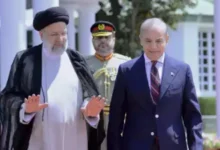Global Watch – How China’s Aggression is Being Fueled by Taiwan’s Poll Results
In the most recent presidential election held in Taiwan, sometimes referred to as the Republic of China, the Democratic People’s Party (DPP) won for the first time ever—three terms in a row. The DPP’s win is seen as a rejection of China’s occupation strategy for Taiwan as much as a setback. Following these elections, China has taken a more assertive stance, aiming to dominate the South China Sea entirely, beginning with Taiwan, the first “island chain.”

The history of the island country is firmly ingrained in the tense relationship between China and Taiwan, which has been escalating over the last several years. Taiwan, which is divided from China by the Taiwan Strait, became known as the Republic of China in 1949 after Mao Zedong’s Communist Party defeated Chiang Kai-shek’s nationalist government in China, forcing the latter to flee to Taiwan. However, Kai-shek’s Kuomintang Party (KMT) imposed martial law on the island country from 1949 to 1987, and Taiwan didn’t have its first democratically elected president until 1992.
Nonetheless, Taiwan is still seen by the People’s Republic of China as a province gone rogue and as an essential component of China. The CCP has traditionally aimed for “peaceful reunification of Taiwan,” but under Xi Jinping’s direction, this objective has taken on more significance. What is clear from Xi’s 2019 announcement of his “One Country, Two Systems” approach is his continued advocacy for a unification process. The majority of Taiwanese people, however, have angrily rejected this approach.
There are two primary political groups in Taiwan: the DPP, which is wholly opposed to Communist China, and the Kuomintang Party (KMT), which mostly maintains a pro-China stance and supports China’s 1992 consensus.
In contrast to the KMT, the DPP, which has traditionally been linked to formal independence, upholds the “status quo” and democracy while refraining from formally announcing the island nation’s independence from China. The DPP now has a strained relationship with mainland China as a consequence of this. After Taiwan’s 2016 presidential election, relationships soured when previous president Tsai Ing-wen chose to diversify commerce rather than strengthen cross-strait ties with Beijing. Beijing therefore cut all diplomatic connections with Taipei.
Former vice president and incoming president Lai Ching-te expressed support for the “status quo” in ties to China and expressed a desire for Beijing to be contacted again. But the PRC painted Lai as a “separatist” during Taiwan’s presidential election and attempted to frame the vote as a choice between war and China for the people of Taiwan. Weeks before the election, Xi Jinping reaffirmed that Taiwan’s reunification with China was “inevitable.” Beijing made many efforts to use misinformation operations and cyberattacks to sow political splits that would erode public support for the DPP. This further demonstrated China’s active meddling in Taipei’s domestic political affairs. But ultimately, as the electoral mandate indicates, China’s efforts were in vain.
Even though China’s response to the DPP’s election win was somewhat muted, it was clear that Xi would continue to uphold the “One China” policy, which would affect cross-strait ties. But in an effort to scare Taipei, Beijing has increased its use of non-kinetic tactics—as opposed to real combat—in its “grey-zone” warfare since the election results. An increasing number of planes, warships, observation ships, and aircraft patrols over and around the strait have been seen by China as a regular display of force intended to weaken Taiwan’s democracy.
It is possible to interpret China’s recent balloon bombardment, which saw surveillance balloons being launched over Taiwan’s airspace, and the regular naval vessel activities as standard Chinese strategies intended to scare Taiwan. Following the deaths of two Chinese fishermen involved in unlawful activities in Taiwanese seas, the historically Taiwanese-controlled Kinmen Islands have seen increased patrols, which are examples of China’s gray-zone tactics against Taipei’s popular mandate. China held Taiwan accountable for the two Chinese fishermen’s deaths, despite the fact that their speedboat overturned close to Kinmen Seas while Taiwan’s Coast Guard was pursuing them. Taiwan’s defense report claims that China is using these measures to threaten Taiwan and force the people to follow its declared policies.
Lately, it has also been noted that Beijing has often been seen doing military exercises close to Taiwan. This is seen as a further indication that China is stepping up its military drills close to the Taiwan Strait. Furthermore, the Chinese Communist Party (CCP) said that Beijing will be “firm” in promoting the cause of Chinese reunification and restated its policy for settling the Taiwan problem in the new age during the most recent National People’s Congress meeting. It’s interesting to note that, in contrast to earlier reports, Premier Li Qiang did not mention “peaceful” reunification in his report presented at this conference. This shows how China’s position toward the island country is becoming more rigid. It also emphasizes the potential for China to pursue its goal of “reunification” by means other than a peaceful approach.
Consistent with its objective of achieving complete modernization by 2035, China has consistently increased its defense spending throughout the years. Despite Taiwan’s slow-growing economy, the defense budget has grown by 7.2% this year, with a focus on the country. Although many people think that China’s military modernization will not result in a full-fledged conflict anytime soon, it is directed towards the country’s reunification process. Beijing is now using its “grey area” strategies to establish its dominance over the Taiwan Strait, and as long as the DPP is in power, it is probably going to keep meddling in Taiwan’s democratic system.
Beijing’s measures, nevertheless, are likely to fail given the public mandate’s opposition to reunification with China and might further solidify the DPP’s position in Taiwan. Additionally, Taiwanese citizens would become more outspoken in their opposition to China’s bullying actions.







